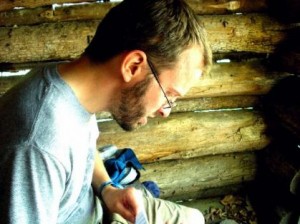[Christopher Martin]: It interests me that your poem “Absentee,” from the current r.kv.ry quarterly, appears in a special issue on “faith and doubt.” Upon reading your poem, a couple connections between it and the issue’s theme came to mind, but I’m curious to hear about the connections you see. How do faith and doubt inform your poem? And in turn, what does your poem reveal about these two concepts that tend to be viewed dualistically?
[William Kelley Woolfitt]: “Absentee” meditates on concrete expressions of faith and doubt, or belief and unbelief, as they relate to body and land. In the poem “Sunday Morning, 1950,” Irene McKinney creates a list of objects that sacralize the physical and physicalize the sacred: “tight, white sandals” and “dust in the road, and on the sumac,” “narrow benches we don’t fit” and “shaven hilly graves.” The objects in “Absentee” try to carry on that same work, to affirm that God is present in creation, even in hills and streams that have been exploited and profaned.
[CM]: “Absentee” is very much a concrete poem, even a bodily poem. The lines “scattershot ice a bruising reminder to me / that I am really in my body, and not in a dream, / when I go out to smell the world set alive” perfectly capture the poem’s presence in the flesh and in the world. Yet, the poem is titled “Absentee,” and, to return to the previous question, it appears in an issue centered upon two words that are abstractions. In what ways does your poem interact with its title? And in what ways might such interactions lend physicality to the issue’s theme?
[WKW]: I borrowed my title from Barbara Rasmussen’s book Absentee Landowning and Exploitation in West Virginia: 1760 – 1920. The speaker of my poem, I think, is committed to (or wants to commit to) being not an absentee, but a “presentee,” a dweller, a witness who strives to be fully awake, alive, and aware of body, environment, and the interconnections between the two. Kathleen Norris suggests the connection between faith and heart when she states that “if we can determine what it is we give our heart to, then we will know what it is we believe.” In my poem, it is how the speaker lives in his body and how he inhabits his world that reveals to him what it is he believes.
[CM]: This issue of r.kv.ry features some gorgeous artwork by Suzanne Stryk, and “Eclipse Salamander,” which accompanies your poem, might be my favorite. Do you happen to know if there was any purposeful arrangement among the artwork and text for this issue, specifically as related to “Absentee” and “Eclipse Salamander”? And whether their arrangement was or was not purposeful, how do you see Suzanne’s work as complementing (or complicating) your poem’s narrative?
[WKW]: While I don’t know much about how the art and text for this issue were arranged, I love Stryk’s work, and “Eclipse Salamander” is one of my favorites. I keep thinking it would make a wonderful book cover! I like to imagine that the salamander is a creature that inhabits two worlds (land and water) that are different but interdependent; thus, “Eclipse Salamander” seems an especially apt companion for “Absentee,” whose human speaker envisions or experiences a range of dualities not as mutually exclusive but as interdependent.
[CM]: How does “Absentee” fit in the larger body of your work?
[WKW]: For several reasons, “Absentee” plays an important part in my manuscript Beauty Strip. One reason is that I wrote the first version of “Absentee” ten years ago, and now I can see that it marks an important shift in my writing—from poems that were chiefly autobiographical (if I wanted to be harsh, I might say blinkered or self-absorbed) to poems that seek out closer and more intricate connections between speaker and environment, community, and history.
Another reason is that “Absentee” joins the title poem “Beauty Strip” and a number of others in the manuscript that take a closer look at extractive industries, mountaintop removal, subsidence, habitat loss, and so on. And yet another reason is that the well-house in “Absentee” reflects my interest in a variety of small utilitarian structures that mark our human passage on the earth – granaries, corn cribs, mills, coops, and so on. (A related poem, “Time, the Springhouse,” was published by Quarterly West.)
Christopher Martin is author of the poetry chapbook A Conference of Birds (New Native Press, 2012). His poems and essays have appeared or are forthcoming in Shambhala Sun, drafthorse, Still: The Journal, Thrush Poetry Journal, Buddhist Poetry Review, Town Creek Poetry, The Southern Poetry Anthology, Volume V: Georgia, and elsewhere. Chris lives with his wife and their two young children in the northwest Georgia piedmont, between the Allatoona Range and Kennesaw Mountain.



Pingback: Absentee | Rkvry Quarterly Literary Journal
Pingback: Absentee | Rkvry Quarterly Literary Journal